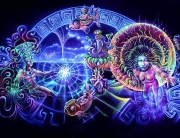As the reader is well aware, a compass is a device to help travelers know which direction they are heading or gives them the ability to choose the direction they wish to go. This is achieved by the triangulation between an agreed-upon stationary point, in this case magnetic north, your current position in relationship to that point and a predetermined direction in which you wish to head.
As a result, the functioning of a compass offers an excellent analogy for understanding how your orientation in consciousness is determined. What then is that triangulation in consciousness that guides the spiritual pilgrim on the path to the attainment of their goals?
First, and most important, is to identify that stationary point in consciousness that determines direction.
Perhaps at this juncture, the reader might question if there is a singular point that identifies direction for all who travel the path of conscious determination in their lives. To complicate the question is whether the fact that consciousness is dynamic, and therefore, an immovable, unchangeable point of reference even possible. If we agree there is, we create dogma—if not, a compass in consciousness is unrealistic.
How then does one orient himself or herself in consciousness and determine the direction to proceed? To say that each individual identifies their own stationary point in consciousness might seem too simplistic, but in actuality it is truth. Everyone has a point of reference upon which he or she bases the actions of their lives. It may be a complex compilation of thought or a simple belief, but whatever it is, it is theirs and it is their point of reference.
As the reader is aware, the needle of the compass always points to magnetic north, as does one’s consciousness always refer to their point of reference. Yet, there is one more action necessary for a compass to be accurate—and that is to turn its dial so that the north on the face of the compass coincides with the direction the needle is pointing.
How then does this essential act for accuracy translate into our image of a compass of consciousness? Just as the needle of the compass innately knows which direction to point, so does your consciousness know without conscious intervention your natural point of reference.
We mentioned earlier in this concept that the point of reference ranged from complex thought to simple belief, which sounds rather conscious, but when understood as expressions of an inner knowingness, this imagery holds true.
So what then is the act of turning the dial to coincide with the stationary point in consciousness?
It is your conscious acknowledgement of your point of orientation and the adjustment of your life to be in alignment with it—the result being an accurate reading of the direction you are traveling and the ability to chart an accurate course to your desired destination.
Everyone has been given a compass of consciousness as part of the provisions for their journey through life, but not everyone chooses to take advantage of this valuable asset to accurately chart a course of action in their lives.
Perhaps, if you find yourself either lost in your life or not where you desired to be, you might want to pull your trusty compass of consciousness from your pocket and adjust your life to coincide with your point of reference—and you will never be misguided or misdirected again.







Leave A Comment